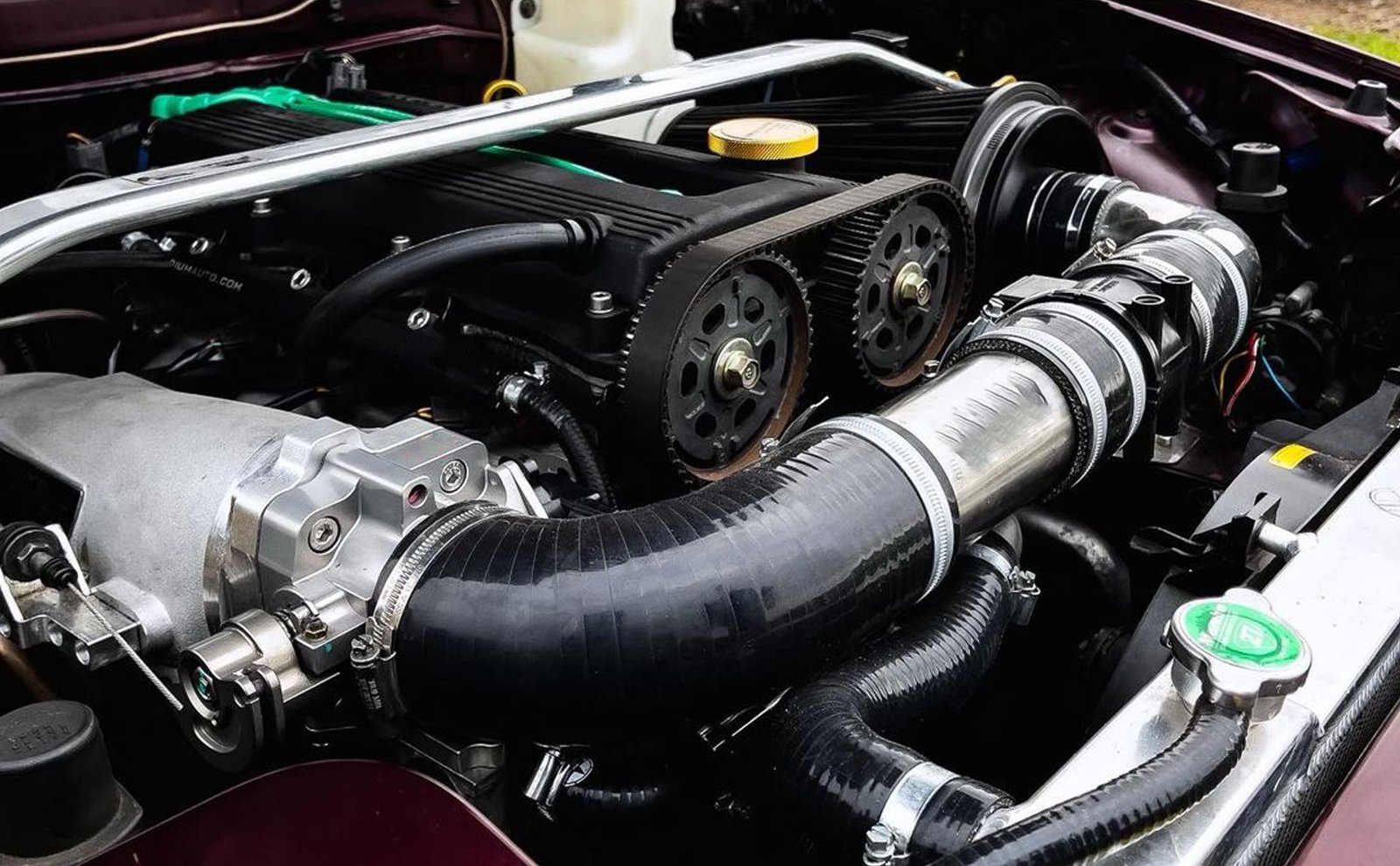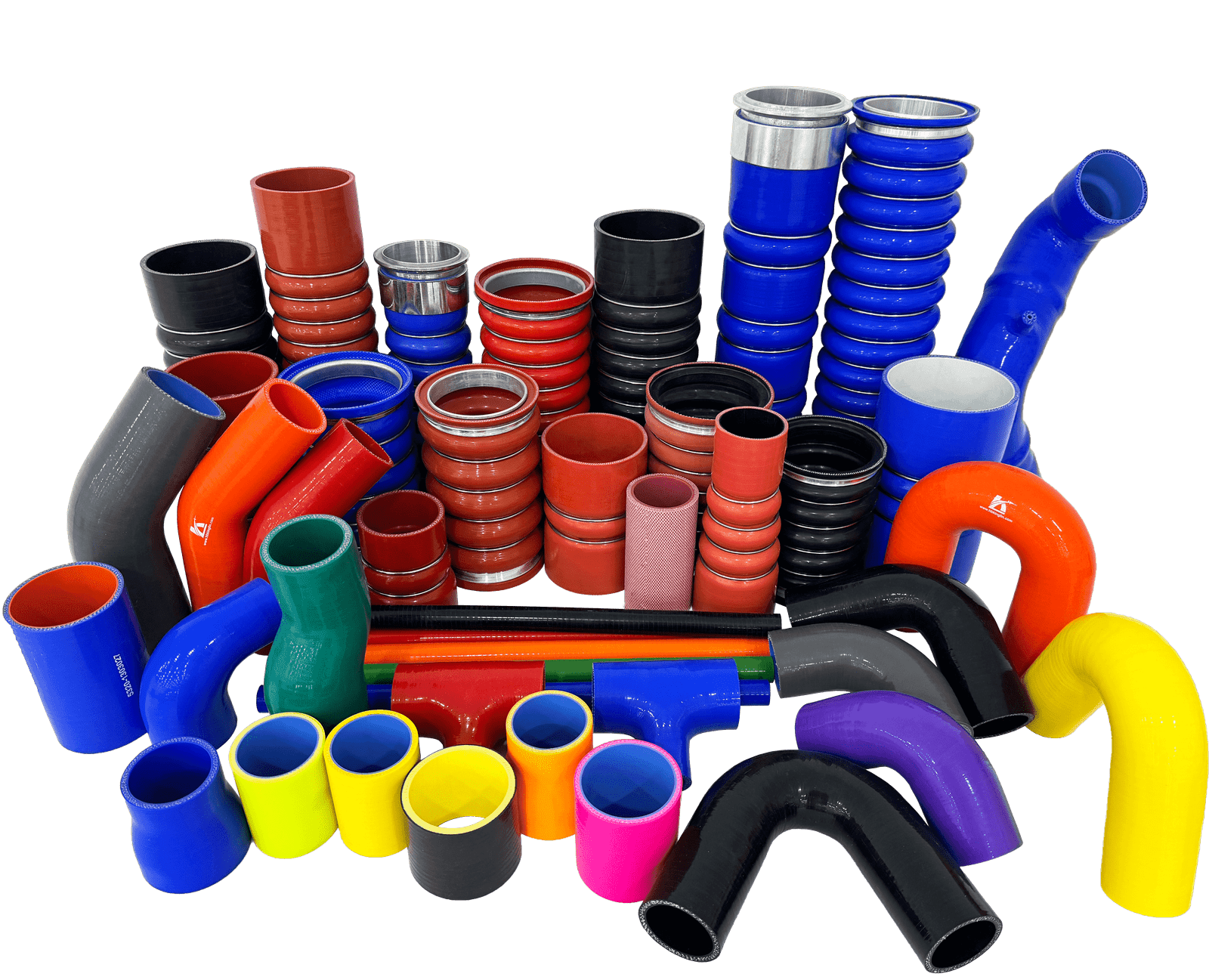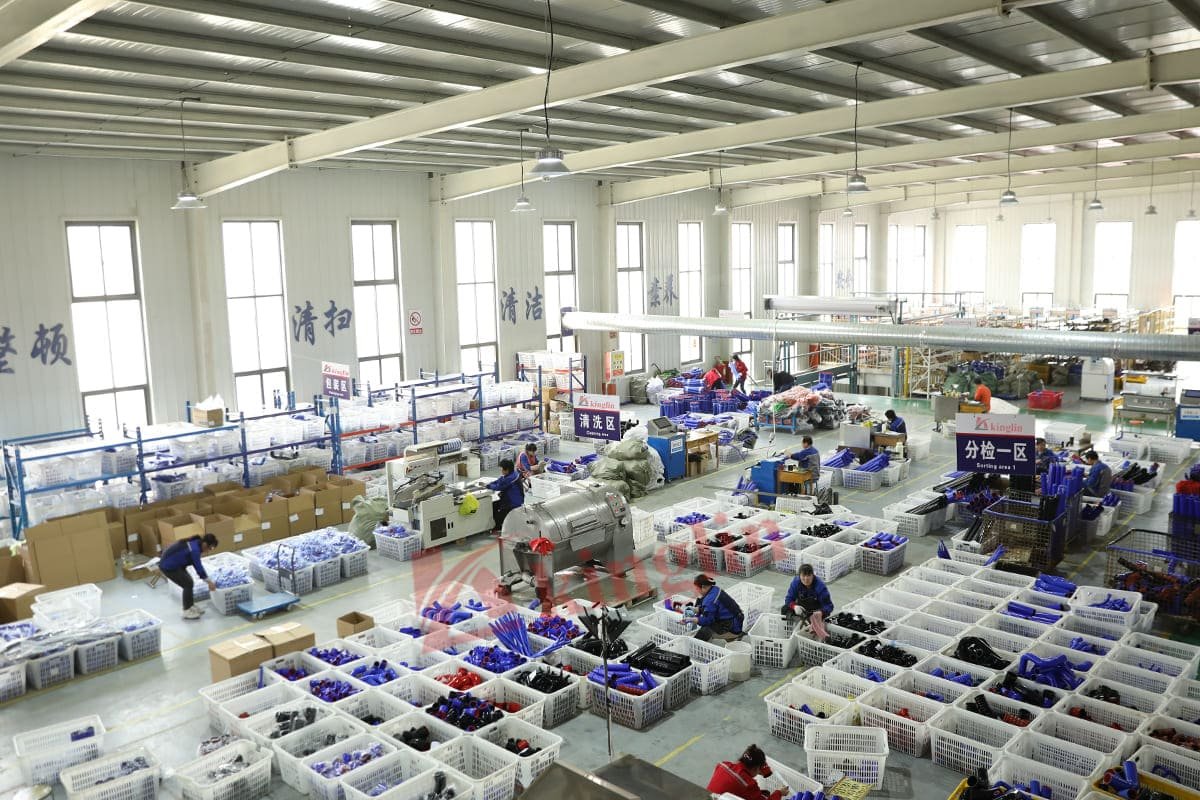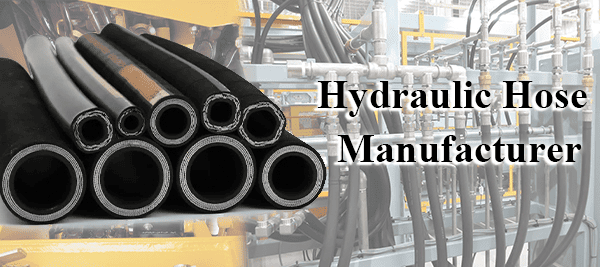Silicone hoses are widely used in various industries, especially in cars, trucks, and agricultural machinery. Thanks to their excellent performance, they are very popular. This guide will give you all the important information about silicone hoses. If you want to learn more, keep reading!
What is a silicone hose? Introduction to Silicone Hoses
Silicone hoses are flexible hoses made from silicone rubber and reinforced materials. They are widely used in various industries. Compared to rubber hoses, silicone hoses have better heat resistance, durability, flexibility, aging resistance, and corrosion resistance. Since silicone is non-toxic, odorless, and performs well, it is highly popular. You can also customize silicone hoses to fit your specific needs.

Silicone Hose Type
There are many types of silicone hoses, each designed for different applications. Some common types include:
- Standard Silicone Hose
- Truck Silicone Hose
- Silicone Hose Kit
- Extruded Silicone Hose
- Radiator Silicone Hose
- Heater Silicone Hose
- Fluorosilicone Hose
- Custom Silicone Hose

Each type serves a specific purpose to meet different industry needs.
Silicone Hose Construction
The structure of silicone hoses ranges from single-layer to multi-layer designs, which can be customized based on your needs. Below is a breakdown of the common silicone hose structure:
Inner Layer
The inner layer is typically made of high-quality silicone rubber. It has a smooth surface, free from bubbles or defects. Standard silicone hoses are not oil-resistant, but for applications requiring oil resistance, the inner layer can be reinforced with a fluorosilicone lining.
Reinforcement Layer
The reinforcement layer is made of polyester, aramid (Kevlar), or stainless steel, helping the hose maintain its shape, withstand high pressure and temperatures, and prevent collapsing or excessive stretching under pressure.
Outer Layer
The outer layer is made from a more durable silicone compound, designed to withstand UV exposure and environmental factors. Depending on the application, it may have a smooth silicone finish or a textured fabric finish. The outer layer also provides protection against abrasion, cuts, and physical damage.
Customization Options
In addition to standard silicone hoses, you can also customize silicone hoses. There are many customization options for silicone hoses to meet your different application needs. Here are some common customization options for silicone hoses.
Customized colors
The most common colors of silicone hoses include red, blue, black, and green. It can also be made in a variety of colors. You can choose the color you want according to the bypass color card.
Size and diameter
The outer diameter, inner diameter, and length of the silicone hoses can be made according to your requirements to ensure that they can perfectly adapt to your application
Wall thickness
The silicone tube can be customized according to your application requirements. The thicker the wall, the greater the pressure it can withstand. The thinner the silicone hoses is more flexible
Reinforcement layer
- Fabric reinforcement layer: You can choose polyester or aramid. Polyester is usually used for ordinary low-pressure applications, but aramid can produce higher temperatures and can be used in high-performance applications that require high temperature and high-pressure resistance
- Stainless steel reinforcement layer: It is more pressure-resistant than aramid and is suitable for applications that require high-pressure resistance and durability
Fluoro-Lined Silicone Hose
Fluoro-Lined Silicone Hose is a silicone hose with a special lining material. The inner layer is made of fluorosilicone FMVQ material. It is fuel-resistant and oil-resistant. Ordinary silicone materials are not oil-resistant. If they are exposed to oil for a long time, they will age and lose their elasticity. If your application contains oil, oil mist, fuel, or other chemicals, you need to use a silicone hose with an inner layer of fluorosilicone material.
Silicone Hose Work Temperature
High-temperature ranges are as follows:
Polyester-reinforced silicone hoses
working temperature -40 ℃ (-40 ℉ ) to 180 ℃ (356 ℉ )
Aramid(Nomex) reinforced silicone hoses
working temperature -40 ℃ (-40 ℉ ) to 220 ℃ (428 ℉ )
Fibre glass-reinforced silicone hoses
working temperature -40 ℃ (-40 ℉ ) to 260 ℃ (500 ℉ )
Silicone Hose Work Pressure
The working pressure of silicone hose mainly comes from the structure of the hose, the reinforcement material, and the application environment. The following is a breakdown of the pressure of silicone hose.
Factors affecting the working pressure of silicone hose
Reinforcement material
Polyester
Pressure range: up to 3 bar (43.5 psi).
Usually suitable for medium-pressure applications
Aramid
Pressure range: up to 10 bar (145 psi) or higher
High-pressure resistance is often used in high-performance applications such as racing
Stainless steel wire reinforcement layer
Pressure range: up to 10 bar (145 psi) or higher, depending on the number of wire layers.
It has excellent pressure resistance and is used in high-performance and high-pressure systems
Hose diameter
The hose diameter also determines the pressure resistance of the silicone hose. A hose with a smaller diameter can withstand more pressure because the force of a small-diameter silicone hose is more concentrated and stable, reducing the risk of hose expansion and bursting
Wall thickness
The more layers of silicone hose, the higher the pressure it can withstand
Thinner layers are more flexible but have lower pressure resistance
Silicone Hose Overview of the Manufacturing Process

- Raw materials: prepare high-quality silicone rubber and reinforcement materials
- Mixing: test whether the performance of silicone hose raw materials meets customer needs and mix organic silicon compounds with curing agents and additives
- Production: silicone hose production, and test whether it meets the standards during the process
- Vulcanization/curing: put the silicone hose into the vulcanization box for curing
- Cleaning and de-molding: clean the silicone hose cellophane and de-mold it
- Cutting: cut according to size
- Testing and quality control: 3D tooling to test whether the silicone hose meets the requirements, measure whether the size is correct, and laboratory testing
- Cleaning and packaging: clean the silicone hose and pack it as required
Silicone Hose Application
Silicone hose has excellent high-temperature resistance and durability. It is widely used in various industries. The following are the most common application areas of silicone hose
- Automotive industry: Applied to automotive cooling systems, air intake, turbocharging systems, etc.
- Industrial applications: Suitable for industrial applications that require flexibility, durability, and high-temperature resistance
- Racing cars: Engineering machinery used in cooling systems, air intake and turbocharging systems, etc.
- Marine and shipbuilding industry
- Aerospace applications
- Food industry
- Pharmaceutical industry
Silicone Hoses vs. Rubber Hoses
Which one is more suitable for your application, silicone hose or rubber hose? Let us introduce the difference between these two materials in detail.
Material difference
Silicone hose is made of high-quality silicone rubber and other reinforcing materials. It has good high-temperature resistance, flexibility, durability, and other properties. It is non-toxic, odorless, weather-resistant, ozone and ultraviolet
Rubber hose is made of synthetic rubber nitrile rubber, chloroprene rubber, and other materials, and can be used specifically for oil-resistant applications, EPDM rubber hose can be used in air and water, but not in oil
Temperature resistance
- Silicone hose: Silicone hose can be used at high temperatures, usually in the temperature range of -60°C to +280°C
- Rubber hose: The high-temperature resistance of rubber hose should be lower than that of silicone hose
- Natural rubber: about -40°C to +80°C
- EPDM: about -40°C to +150°C
- Nitrile rubber: can withstand temperatures up to +120°C.
Chemical and oil resistance
Silicone hose: Not suitable for use in oil and fuel, silicone hose is more suitable for water and air
Rubber hose: Many rubber materials, such as nitrile rubber, have excellent oil and fuel resistance. Rubber hoses are more suitable for fuel lines and applications that require oil and chemical resistance.
But other rubber hoses like EPDM are suitable for water and steam, not suitable for oil
Durability and aging
Silicone hoses are very durable and can generally be used for 10-20 years or even longer because silicone hoses have good UV resistance and aging performance and can be used at extreme temperatures
Rubber hose:
Rubber hoses have good durability, but their performance is not as good as silicone hoses when used under UV, ozone, or extreme temperatures, and their performance will deteriorate over time
Flexibility
Silicone hoses are more flexible than rubber hoses
Cost
- Silicone hoses: Silicone hoses cost more, but they are more beautiful and high-temperature resistant than rubber hoses, have a longer service life, and are not easily damaged when used as required.
- Rubber hoses: Rubber hoses are cheaper than silicone hoses and can be used in applications that do not require so much temperature and flexibility
Features and Benefits of Silicone Hoses
High-temperature resistance
Silicone hoses are more suitable for high-temperature environments than rubber tubes and are suitable for use in a temperature range of -60°C to +280°C
Flexibility
Silicone hoses are more flexible and will not become inelastic, hard, or brittle after a long time of use
Durability
Silicone hoses can be used for a long time and may be more durable than the vehicle itself, reducing the cost of replacement and maintenance
Chemical resistance
Silicone hoses are resistant to acids and alkalis, oxidants, water, and alcohol, and are non-toxic and odorless
Beautiful appearance
Silicone hoses can be customized in a variety of colors, surfaces, and shapes, and look very beautiful after opening the hood
Shock and noise reduction
Silicone can effectively absorb vibrations and suppress noise
Choosing the Right Silicone Hose Supplier
Check product quality
Confirm whether the supplier you are looking for is a factory and whether it has certificates: ISO9001, IATF16949 quality management system certification
Whether there is a product warranty period
Whether the supplier has the ability to test the product, can it provide a quality inspection report, and whether there are quality inspectors to test whether the hose performance and quality meet your requirements.
Does the supplier provide samples for you to check whether the quality meets your requirements?
Customization capability
Whether the product categories are complete.
Whether product customization is supported: There are professional designers who design 3D drawings for free, and can customize product colors, sizes, shapes, logos, etc. according to the sizes, drawings, samples, etc. you provide, and provide personalized solutions.
Supplier experience
Industry experience: Suppliers with rich experience in silicone hose manufacturing, knowledge of the product, etc., and can deliver on the agreed time.
Production capacity
Can the supplier meet your order volume, whether it is a large or small order, and whether the supplier has sufficient production capacity to meet it?
About the factory: Can it support factory inspection?
Check whether the delivery time can be shipped according to the agreed time.
After-sales service and technical support
Can the supplier provide professional knowledge and capabilities such as material selection and silicone hose specifications?
Customer service: Consider the supplier’s response speed and whether there is an after-sales guarantee.
Sample inspection: Before mass production, ask the supplier whether it provides sample inspection, which can help you understand the quality of the product.
Delivery and transportation
Transportation: Make sure the supplier can provide reliable transportation options and whether it has global export, customs clearance, and international transportation capabilities.
Packaging: Ask about the packaging process or whether the packaging can be customized according to your needs.
Identifying Silicone Hose Failures (Cracks, Leaks, etc.)
Silicone hoses are durable and reliable, but improper use or installation may cause problems with silicone hoses. The following are common silicone hose problems
Common silicone hose failures

- Cracks: There are obvious cracks on the surface of the silicone hose
- Reasons:
- Use time is too long: Long-term use in high temperatures and ultraviolet light can cause this situation
- Over-tightening the clamp: Over-tightening the clamp may cause cuts to the hose
- Overheating: Long-term use outside the silicone hose temperature range will damage the hose
- Leakage or leakage: Silicone hose leaks
- Reasons: Improper installation of the silicone hose, clamps are tightened too tight or too loose The silicone hose is damaged or the joint is not connected and leaks occur
- Hose deformation: The hose is dented, bulged, or unevenly shaped
- Reason:
- The pressure is too high and it is working outside the standard pressure range of the silicone hose
- Contact with incompatible chemicals will cause the material to soften, and then using it under pressure will cause the hose to deform
- Wear: The hose is obviously worn or thinned
- Reason: The surface of the hose rubs against sharp edges for a long time, which will cause the hose to be damaged
- Delamination: The inner and outer layers of the silicone hose are separated
Preventing silicone hose failure
Proper installation
- Avoid excessive bending or contact with the sharp edges of the car
- Choose the appropriate size or shape of silicone hose for the application
- Choose the appropriate clamp
Daily maintenance
- Regularly check for wear or damage
- Replace any problematic hose immediately
Use compatible materials
- Purchase good quality silicone hose
FAQS
How long do silicone hoses last?
Silicone hoses are very durable and have a much longer service life than rubber hoses. Under normal circumstances, they can be used for 10-20 years
Is Silicone Hose Oil-Resistant?
Silicone hoses are not oil-resistant because they are porous. Long-term contact with oil will cause the silicone hose to degrade, expand, and fail.
Fluorosilicone rubber hoses can be selected for applications that require oil resistance.
How to bend silicone hose
When bending silicone hoses, make sure that the bending radius is not less than three times the hose diameter. Minor bends can be made manually and gently. Avoid forming sharp corners, otherwise the flow of liquid or gas will be blocked. You can use a hot air gun to heat the hose and make it soft before bending it. Be careful to avoid excessive bending or overheating.
Conclusion
Silicone hoses are widely used in automobiles, industry, and other fields due to their excellent high-temperature resistance, durability, UV resistance, and flexibility. When choosing a suitable silicone tube, you need to determine the appropriate product based on the specific requirements of the application. I hope this article can help you understand silicone tube products.



